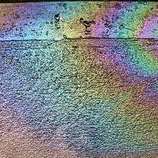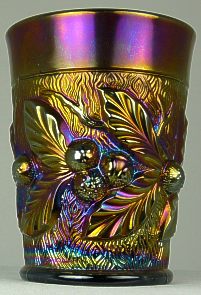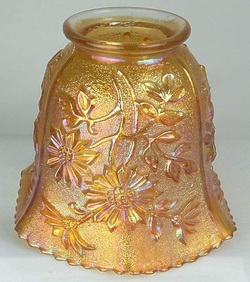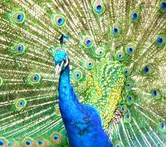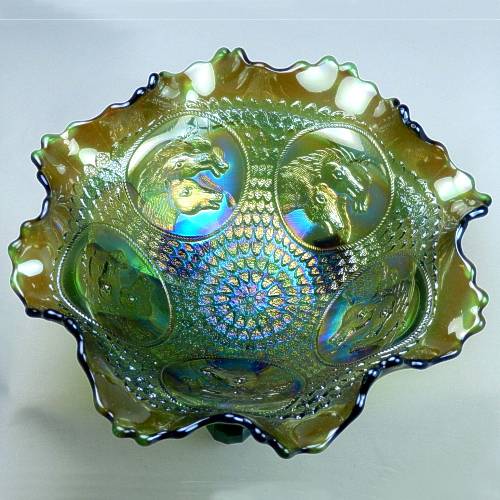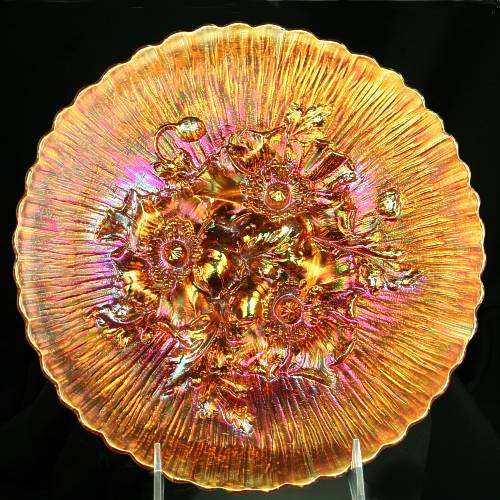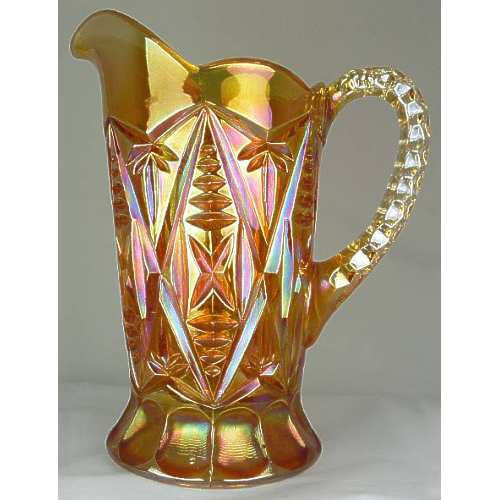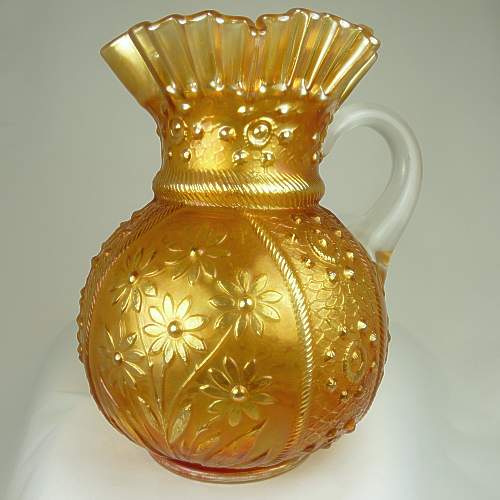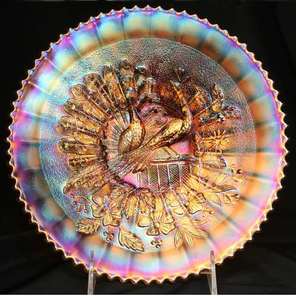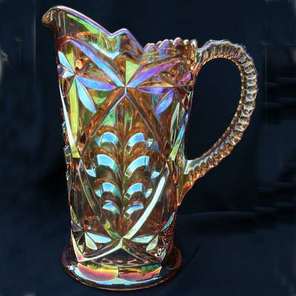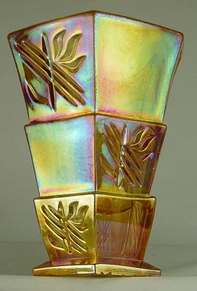What does "Iridised" mean?
“Iridised” (sometimes spelled “iridized”)? is a rainbow-like effect on the surface, a bit like soap bubbles or the effect of oil-on-water that you sometimes see in puddles. You can see the same sort of effect on the surface of a CD too. The feathers of some birds and the wings of some butterflies also have a shimmering iridescence.
The varying effect of iridescence on glass is shown clearly in these three images, from three different Carnival Glass makers.
Left to right: Acorn Burrs, Northwood; August Flower (Imperial); Horse Medallion, Fenton.
Left to right: Acorn Burrs, Northwood; August Flower (Imperial); Horse Medallion, Fenton.
The key point is that iridescence is essential - if it’s not iridised, then it’s not Carnival Glass.
How was the iridescent effect created?
Carnival Glass was often iridised using ferric (iron) chloride sprayed onto the hot glass. This gave an orange, or "marigold" colouring. Stannous (tin) chloride was also used (and still is the iridescent spray of choice for iridising glass, for example by Isle of Wight Glass studio).
Doubtless Carnival Glass makers had their own formulae for making up their iridescent sprays, and many guarded them carefully! Larry Freeman reported that "the burnished gold Aurene color came from the use of tin chloride. The addition of iron chloride deepened this gold to a reddish tint" (Larry Freeman "Iridescent Glass"). Chloride of antimony applied on top of iron chloride is supposed to have produced blue colouring.
Webb & Sons, in the UK, made iridised Bronze Art Glass (from 1878 onwards), and their application for patent stated that: "the glass articles are exposed, while in the nearly molten state after blowing, and before annealing, to the fumes generated by placing chloride of tin, alone or mixed with the nitrates of barium and strontium, upon a hot plate or spoon. During this process the articles are placed in a muffle or chamber into which the fumes are introduced".
The renowned maker of Classic Carnival Glass, Harry Northwood, explained it perfectly: "Ordinary Chloride of Iron as bought at wholesale drug stores costs 3½ cents a lb. ... spray on glass when finished ready for lehr... glass must be fairly hot." (“Harry Northwood, The Wheeling Years” by Heacock, Measell and Wiggins). Harry added some extra tips: "Spray on glass very hot for Matt Iridescent and not so hot for Bright Iridescent" which is how satin (matt) and radium (bright) effects were achieved on Carnival. One extra tip that Northwood gave is a very interesting one indeed. He explained that spraying iron chloride on hot glass, quickly followed by a second spraying with a tin solution "gives beautiful effects". The tin solution was stannous chloride – still used by glassmakers today - to produce shimmering iridescent effects that are often quite light and without the heavy “staining” produced by the iron salts. It seems most likely that this double doping of a light ferric chloride spray followed by a stannous chloride spray may indeed have been what gave rise to the magnificent effect known as pastel marigold (as shown on Northwood's Peacocks plate, below).
Here are several examples from Classic Carnival Glass makers around the world, showing the very different marigold effects that were achieved. Marigold Carnival Glass is always on a clear (crystal) base glass, the different iridescent effects being achieved by such factors as the temperature of the glass when it was sprayed, the amount of spray applied, and how many times it was sprayed, and the varying thickness of the moulded glass and its pattern. The iridescent effect also changed in appearance according to the colour of the base glass.
Above
Left: Northwood Poppy Show plate in pumpkin marigold.
Centre: Brockwitz Diamond Cut Shields pitcher in their "signature" brilliant multi-coloured iridescence.
Right: Fenton Bouquet pitcher in a more subtle, satin iridescent finish.
Below
Left: Northwood Peacocks plate in pastel marigold.
Centre: Plume Panels and Bows pitcher with pastel, multi-coloured iridescence.
Right: Hortensja (Poland) Athina vase with a strong iridescence showing shades of yellow, blue, purple and pink.
